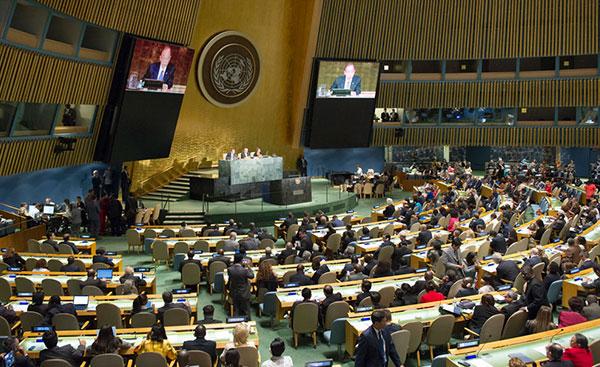
by Ahyousha Khan 29 November 2021
The Nuclear Non-proliferation treaty entered into force in 1970, after two years of opening for signatures. In 2020 it completed its 50 years of entry into force and in the 1995 Review Conference, the treaty was extended indefinitely. Treaty was a grand bargain between nuclear and non-nuclear-weapon states, where non-nuclear-weapon states forgo their right to acquire nuclear weapons in exchange for access to peaceful uses of nuclear technology. Many scholars, especially in the west, consider the non-proliferation treaty as a success story because of the number of its members, which are currently 190, and because of the fact that the treaty was successful in controlling the number of nuclear proliferators. However, “NPT as a success story” requires careful reassessment and deliberation. Otherwise, this major cornerstone of the non-proliferation regime will not be able to cater to evolving circumstances and hence will continue to lose its importance.
NPT was drafted with the objective to “prevent the spread” of nuclear weapons and technology, “promote cooperation” for the peaceful uses of nuclear technology, and to achieve the goal of “nuclear disarmament- general and complete disarmament”. NPT member states review the treat and its implementation after every five years in NPT Review conference; during 1995 NPT Review conference treaty was extended for an indefinite period of time. Treaty was extended for an indefinite period of time “under the framework of strengthening the review process, the establishment of benchmarks for non-proliferation and disarmament and establishment of NWFZ in the Middle East”. However, the point of deliberation in this regard is how 25 years down the lane today NPT member states cannot even come to a consensus on the final document of the review conference.
An evolving situation, especially after the 2015 review conference which ended in failure, tensions and differences are growing among the nuclear weapon and non-nuclear weapon states parties of the NPT. 5 nuclear weapon state parties to the treaty and their allies which have access to nuclear umbrella consider NPT as a non-proliferation treaty, which has nothing to do with disarmament. Although, NPT has always been discriminatory in nature as it was bargain non-nuclear weapon state parties expected to have access to peaceful nuclear technology. However, NPT failed NNWS in providing the inalienable right to peaceful nuclear technology for growth and development. This gave rise to a sense of dissatisfaction among the NNWS and hence caused the birth of UN “Treaty of Prohibition of Nuclear Weapons” (TPNW), which regarded nuclear weapons as immoral and call for the ban on nuclear weapons. So far 86 states have signed the treaty and 54 have ratified it, after 50 ratifications it entered into force in January 2021. Nuclear weapon states consider objectives of TPNW devoid of geopolitical and security realities of states. However, the formation of this treaty reveals that NNWS parties to the NPT are very much interested in “general and complete disarmament”. TPNW does not enjoy the support of NWS, thus to validate the nuclear deterrence and discredit TNPW, the US presented an initiative of “ CEND (Creating an Environment for Nuclear Disarmament)” at NPT preparatory committee 2018-2019. Another important issue in the NPT review conferences is the establishment of Nuclear Weapon Free Zones (NWFZ) in the Middle East. Many Middle Eastern states and especially Iran agreed to extend NPT for an indefinite period of time in the 1995 resolution. Other than that continuous nuclear build-up and technological developments by NWS is a concern for NNWS of treaties. These all issues are becoming bone of contentions between nuclear weapon and non-nuclear-weapon states. Some of these issues will become a matter of concern in coming to NPT Review Conference in 2022. This particular NPT Review Conference was scheduled to be held in 2020 but because of the COVID-19 pandemic has been delayed. Year 2020th marked the 50 years of NPT entry into force as well. Other than the conflicting views on non-proliferation and disarmament in nuclear and non-nuclear-weapon states, NPT review conferences and treaty, in general, has so far not been revised according to the changes in a global system. It regards only 5 states as NWS states however in reality there are 4 other states which have had nuclear weapons for quite sometimes and all these states owning to their security concerns are involved in nuclear build-up like 5 NWS of the treaty. This blind eye by the NPT is proving its discriminatory nature and shows that not only TPNW but also NPT is incognizant of the security concerns of the states.
In the current situation where all major powers are involved in rapid militarization (conventional and non-conventional), Cold War disarmament agreements have deteriorated, now new disarmaments agreements are in sight, agreements like JCPOA were not respected by major powers, chances of successful review conference to mark the 50 years of NPT are very bleak. There are many divergent views on various issues held by the parties to the treaty. However, to make the next 50 years of NPT success it is necessary that NPT broaden its scope by addressing its inherent discriminatory nature and addressing the issues which are becoming bone of contentions among member states.
